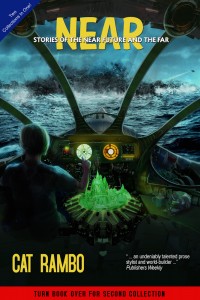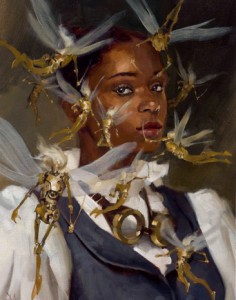I blogged a couple of days ago about arranging stories and my philosophy for such arrangements. I wanted to show those principles in action by looking at the two ToCs for the book Near + Far.
As you may know, the book is divided into two parts, near future stories and far future stories. This allowed us to take advantage of the old Ace double format, where each half is one side of the book. It also meant creating two tables of contents, one for each section.
So here’s the order for the Near section, with some explication:
The collection leads off with the story, “The Mermaids Singing, Each to Each”. The story originally appeared in Clarkesworld, and is one of my favorites, as well as garnering significant critical attention. It’s a story that I knew would be familiar to many of my fans, and perhaps remind them of what they liked about my work, setting them in the proper mood for the rest of the stories. For readers who were new to the work, I knew that this was a good strong start.
The second story is, “Peaches of Immortality,” which originally appeared in Lightspeed Magazine as “The Immortality Game.” This is another strong story although it deals with a different theme than Mermaids. Like the first story, it has a somewhat ambiguous (but in this case arguably happy) ending.
“Close Your Eyes,” which originally appeared in Apex Magazine, marks a movement into more slipstreamy stuff and a venture into more experimental realms. It is a slightly odd story in that it toys a little with meta-fiction, talking about narrative conventions, and even ends with two possible endings, inviting the reader to pick the one they prefer. This seemed like a reasonable choice for a third story, in that it let me nudge the reader a little out of their presumed comfort zone.
“Therapy Buddha,” which appeared in a collection called 2020 Visions, ontinues to present some variety in terms of theme. If I had to sum them up so far, Mermaids is about hope and love, Peaches is about the perils of dwelling in the past, Close Your Eyes is about dependency, and this story is about loneliness and the relationships with the inanimate created by such circumstances. Notice that so far there is not a lot of variety in terms of length. While the other side has several flash pieces, this side only has one.
“Ms. Liberty gets a Haircut” is a change in emotion. It’s a story that, although it has a serious subject, also deals a lot with wordplay and pop-culture references, and is generally a lot of fun for readers. I felt that by now the readers probably had enough misery and ambiguity, and perhaps might like a little play.
“10 New Metaphors for Cyberspace,” a flash piece, marks what is close to the middle of the book. It is a prose poem of sorts, and so seemed a good accompaniment for Ms. Liberty, as well as also being somewhat experimental.
“Memories of Moments, Bright as Falling Dtars,” moves us back into more straightforward narratives and also away from the comic moments that its two predecessors held.
“Real Fur” is one of my earlier stories, but one that I like very much, and which has turned out to be a favorite with a number of readers, I suspect for its tactile qualities. It’s the first of the trio of what I consider the slightest stories of this section, followed by “Not Waving, but Drowning,” and “Vocobox,†which was one of the very first stories that I published.
After that I hit the last two stories in the book, and wanted to finish with fairly strong ones. I chose for the next-to-last story, the story “Long Enough and Just So Long,” which originally appeared in lightspeed and which is, I think one of my best. Or at least one of my favorites.
The final story, “Legends of the Gone,” is not the best in the collection or even close, but it is one that creates an impression that I wanted the reader to close with, a story about endings and goodbyes. It seemed like a very good choice for the final story of this section, particularly knowing that most readers would turn the book over and begin the Far section at that point.
Questions? Comments? What might you have done differently?





